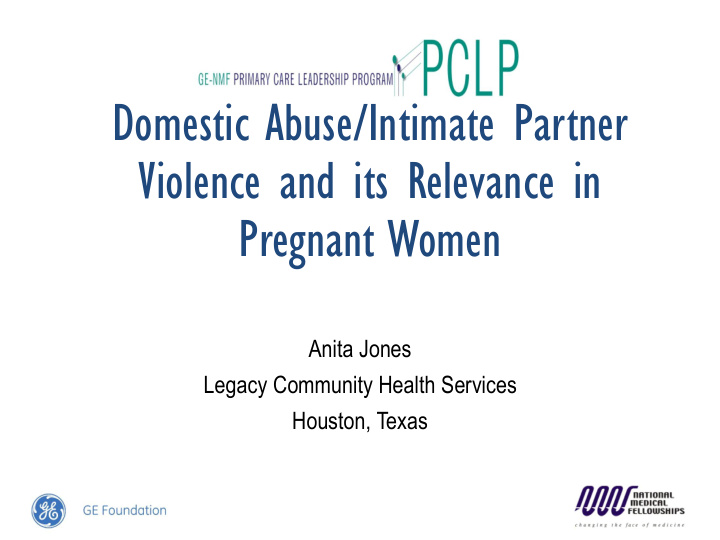



Domestic Abuse/Intimate Partner Violence and its Relevance in Pregnant Women Anita Jones Legacy Community Health Services Houston, Texas
Introduction • Women’s health has become increasingly more important involving many facets of health care. One of those facets that suffers from being underreported are cases that implicate domestic abuse (DA), specifically intimate partner violence (IPV). • My proposed project will hopefully serve some benefit to Legacy Community Health Services as they provide care to their pregnant patients in the future as it relates to Domestic Abuse and Intimate Partner Violence.
Background • IPV can affect as much as 1.5 million women each year (1), a number that only represents those that are documented. IPV in pregnant women living in the United States has an incidence rate of about 4% (1). • These numbers are staggering and although recent efforts have been established by national health organizations to better equip physicians and health providers alike to first be able to identify DA and secondly provide solutions for their patients, there are still many that fall through the cracks.
Methodology Research Design: Access electronic health records system so that I may be able to view • (a) how many pregnant patients receiving services from Legacy within the last six months have suffered from domestic abuse and (b) evaluate if the proper protocol was implemented according the right standard of care. • Visit the appropriate Legacy clinic sites that cater to primarily pregnant patients and evaluate the accessibility of relevant pamphlets, leaflets, posters, and various other educational tools to their patients. Data Analyses: • Analyses will cover the effectiveness of educational tools and protocols that Legacy already has in place as it relates to domestic abuse in pregnant patients and evaluate how it measures up against the national standard of care.
Results Key findings from project • A total of 147 pregnant patients identified as having history of Domestic Abuse. • 60.5% of patients were counseled about behavioral services. • Out of that 60.5%, 23.6% of patients actually received a referral for an appointment with behavioral health; 58.4% of patients declined the services offered; and the remaining 18% of patients although indicated wanting help failed to receive a referral at that time of the visit. • Montrose and Southwest Clinics did not have enough posters and pamphlets accessible to patients.
Discussion • Based on findings, Legacy may need to implement changes that will allow them to better care for their pregnant patients specifically. • Issues with time and scheduling for prenatal visits seem to be a big determining factor. • Protocols also limit the usage of visual posters around the clinics. • Pamphlet stands exist but lack appropriate literature.
Recommendations • Include a cohesive domestic abuse tab on their EHR that mandates they screen at least once for every trimester and again at the postpartum visit. • Provide the necessary training and essential time in their prenatal visits for providers so that they are better equipped to care for their pregnant patients. • Order pamphlets and other appropriate educational literature that is visibly accessible for their patients.
Conclusion • I hope due to the study conducted that changes and adjustments could be made to truly benefit Legacy Community Health Services and the patients they serve. The issues of domestic abuse and intimate partner violence are important ones that I feel need to be addressed as it has the potential to affect everyone. I feel it is even more significant in pregnant populations since it not only affects the well-being of the mother but also that of her unborn child. • Correctly identifying DA/IPV and providing indispensable behavioral services will go a long way in helping Legacy achieve the goal serving their surrounding community.
References: • "Intimate Partner Violence During Pregnancy, A Guide for Clinicians:" Centers for Disease Control and Prevention. Centers for Disease Control and Prevention, n.d. Web. 18 June 2014. <http://www.cdc.gov/Reproductivehealth/violence • Bacchus, L., Mezey, G., Bewley, S., & Haworth, A. (2004). Prevalence of domestic violence when midwives routinely enquire in pregnancy. BJOG: An International Journal of Obstetrics and Gynaecology , 111 (5), 441-445. Retrieved June 19, 2014, from http://onlinelibrary.wiley.com/doi/10.1111/j.1471-0528.2004.00108.x/full • World report on violence and health. (n.d.). WHO . Retrieved June 16, 2014, from http://www.who.int/violence_injury_prevention
Acknowledgements Sincere thanks to: • GE Foundation • National Medical Fellowships Primary Care Leadership Program • Legacy Community Health Services
Recommend
More recommend